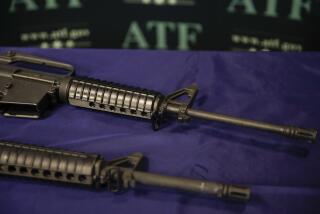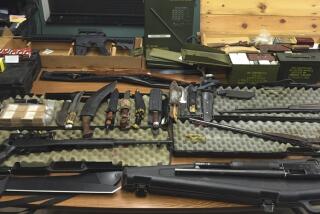FBI Program Puts Computerized Tracers on Firearms : Crime: Virginia, Maryland and District of Columbia feed ballistics information into clearinghouse to find links between shootings. If successful, network will be expanded to Los Angeles.
- Share via
WASHINGTON — The bullet exploded from the .40-caliber Glock pistol, wounding a woman in Baltimore in May, 1992. In July, a few blocks away, a man was shot. In the next two months, two more people were wounded by gunfire in neighboring areas.
Each time, the gunman escaped. Each time, the shooting seemed isolated.
Until recently, there was little chance police would connect such cases, particularly in a city where there were more than 2,914 firearm assaults in 1992.
But the same gun had been used in all four attacks, a link authorities established through an FBI pilot program that uses computers in a manner forensic specialists say may revolutionize the handling of firearm evidence.
For nearly a year, specialists in ballistics from six labs in the District of Columbia, Maryland and Virginia have been forwarding firearm evidence to an FBI clearinghouse dubbed Drugfire.
The FBI began the program because of the recent unprecedented levels of gun violence in the Baltimore-Washington corridor. It marks the first time that state, federal and local authorities have collected ballistic evidence from unsolved shootings in a regional database to determine if the same guns are being used repeatedly, particularly in gang, serial and drug-related shootings.
The system, which cost $1 million to develop, allows departments to compare shootings and gun seizures quickly, case-by-case and from jurisdiction to jurisdiction, to detect patterns that might escape notice if police relied on cumbersome paper files. Of the 774 cases in the database, 35 have been linked.
“The key words are sharing information and linking cases,” said Robert W. Sibert, who is overseeing the program for the FBI. “This is the genesis.”
If the system proves successful, the network will be expanded, with a system planned for the Los Angeles area in a few months.
Robert Conley, president of the American Society of Crime Lab Directors, said that in 19 years of investigative work, he has never seen ballistic specialists link apparently unrelated incidents. “Crimes can occur sometimes within blocks of one another, and people miss the connection,” Conley said.
The analysis turns on the specific markings, unique to each weapon, that are left on bullets and casings after a gun is fired. For years, crime lab technicians have viewed bullets and spent casings under microscopes to match them to firearms. The information often is crucial to proving that a specific gun was used in a crime.
With the explosion of shootings in recent years, ballistic examiners have been inundated; they have trouble keeping track of cases and little opportunity to routinely search for patterns, Sibert said.
As a result, police often have not known that they had evidence linking a suspect or a firearm to more than one offense.
The next refinement of the system will be the design of software eliminating the need to visually compare the images retrieved by a computer.
More to Read
Sign up for Essential California
The most important California stories and recommendations in your inbox every morning.
You may occasionally receive promotional content from the Los Angeles Times.













